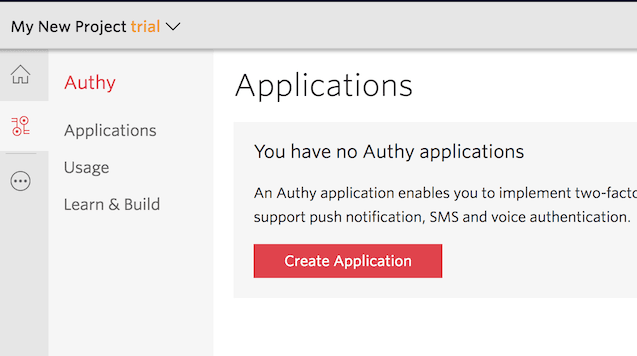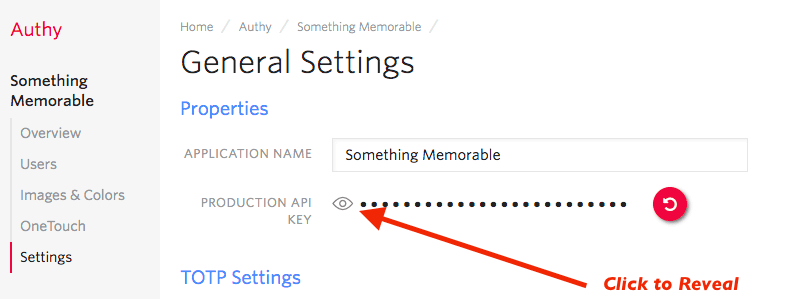Ruby on Rails Quickstart for Twilio Authy Two-factor Authentication
Warning
As of November 2022, Twilio no longer provides support for Authy SMS/Voice-only customers. Customers who were also using Authy TOTP or Push prior to March 1, 2023 are still supported. The Authy API is now closed to new customers and will be fully deprecated in the future.
For new development, we encourage you to use the Verify v2 API.
Existing customers will not be impacted at this time until Authy API has reached End of Life. For more information about migration, see Migrating from Authy to Verify for SMS.
Adding Two-factor Authentication to your application is the easiest way to increase security and trust in your product without unnecessarily burdening your users. This quickstart guides you through building a Ruby and Ruby on Rails application that restricts access to a URL. Four Authy API channels are demoed: SMS, Voice, Soft Tokens and Push Notifications.
Ready to protect a tiny app from malicious hackers?
Create a new Twilio account (you can sign up for a free Twilio trial), or sign into an existing Twilio account.
Once logged in, visit the Authy Console. Click on the red 'Create New Application' (or big red plus ('+') if you already created one) to create a new Authy application then name it something memorable.

You'll automatically be transported to the Settings page next. Click the eyeball icon to reveal your Production API Key.

Copy your Production API Key to a safe place, you will use it during application setup.
This Two-factor Authentication demos two channels which require an installed Authy Client to test: Soft Tokens and Push Notifications. While SMS and Voice channels will work without the client, to try out all four authentication channels download and install Authy Client for Desktop or Mobile:
Clone our repository locally, then enter the directory. Install all of the necessary ruby modules:
bundle install
Next, open the file config/application.example.yml. There, edit the ACCOUNT_SECURITY_API_KEY, pasting in the API Key from the above step (in the console), and save the file as config/application.yml.
It will be loaded when the application begins.
Enter the API Key from the Authy console.
1ACCOUNT_SECURITY_API_KEY: YOUR APP_KEY2
Once you have added your API Key, you are ready to run! Launch Rails with:
./bin/rails server
If your API Key is correct, you should get a message your new app is running!
With your phone (optionally with the Authy client installed) nearby, open a new browser tab and go to http://localhost:3000/register.
Enter your information and invent a password, then hit 'Register'. Your information is passed to Twilio (you will be able to see your user immediately in the console), and the application is returned a user_id.
Go to http://localhost:3000/login and login. A happy screen displays:

If your phone has the Authy Client installed, you can immediately enter a Soft Token from the client to Verify. Additionally, you can try a Push Authentication by pushing the labeled button.
If you do not have the Authy Client installed, the SMS and Voice channels will also work in providing a token. To try different channels, you can logout to start the process again.
1class Api::TwofaController < ApplicationController2def sms()3user = User.find_by(username: session[:username])45if ! user6render json: { err: 'Username Not Found' }, status: :internal_server_error and return7end89response = Authy::API.request_sms(id: user.authy_id)1011if ! response.ok?12render json: { err: 'Error requesting SMS token' }, status: :internal_server_error and return13end1415render json: response, status: :ok16end1718def voice()19user = User.find_by(username: session[:username])2021if ! user22render json: { err: 'Username Not Found' }, status: :internal_server_error and return23end2425response = Authy::API.request_phone_call(id: user.authy_id)2627if ! response.ok?28render json: { err: 'Error requesting Phone call token' }, status: :internal_server_error and return29end3031render json: response, status: :ok32end3334def verify()35user = User.find_by(username: session[:username])3637if ! user38render json: { err: 'Username Not Found' }, status: :internal_server_error and return39end4041response = Authy::API.verify(:id => user.authy_id, :token => params[:token])4243if ! response.ok?44render json: { err: 'Verify Token Error' }, status: :internal_server_error and return45end4647session[:authy] = true48render json: response, status: :ok49end5051def onetouchstatus()52user = User.find_by(username: session[:username])5354if ! user55render json: { err: 'Username Not Found' }, status: :internal_server_error and return56end5758status = Authy::OneTouch.approval_request_status({uuid: session[:uuid]})5960if ! status.ok?61render json: { err: 'One Touch Status Error' }, status: :internal_server_error and return62end6364if status['approval_request']['approval_request'] == 'approved'65session.delete(:uuid) || session.delete('uuid')66session[:authy] = true67end6869render json: {body: status}, status: :ok70end7172def onetouch()73user = User.find_by(username: session[:username])7475if ! user76render json: { err: 'Username Not Found' }, status: :internal_server_error and return77end7879one_touch = Authy::OneTouch.send_approval_request(80id: user.authy_id,81message: 'Login requested for Account Security account.',82details: {83AuthyID: user.authy_id,84Username: user.username,85Location: 'San Francisco, CA',86Reason: 'Demo by Account Security'87},88hidden_details: { test: "This is a" }89)9091if ! one_touch.ok?92render json: { err: 'Create Push Error' }, status: :internal_server_error and return93end9495session[:uuid] = one_touch.approval_request['uuid']9697render json: one_touch, status: :ok98end99end100
And there you go, Authy two-factor authentication is on and your Rails app is protected!
Now that you are keeping the hackers out of this demo app using Twilio Authy two-factor authentication, you can find all of the detailed descriptions of options and API calls in our Authy API Reference. If you're also building a registration flow, also check out our Verify product and the Ruby Phone Verification quickstart which uses this codebase.
For additional guides and tutorials on account security and other products, in Ruby and in our other languages, take a look at the Docs.